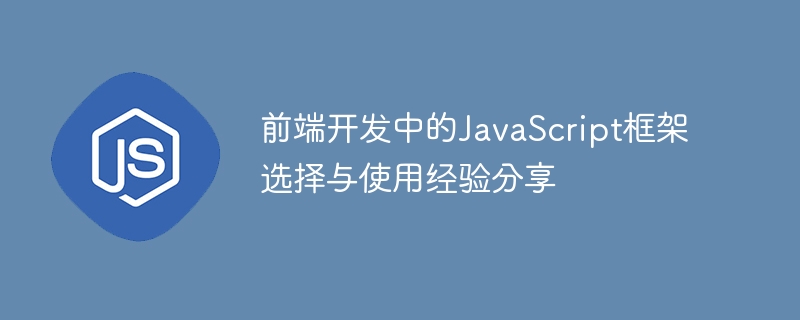

With the development of Internet technology and the continuous expansion of application fields, front-end development occupies an important position in the development of websites and applications. As JavaScript is the core language of front-end development, the selection and use of its framework is particularly critical for developers. This article will share some experiences in selecting and using JavaScript frameworks in front-end development to help developers make informed decisions in actual projects.
1. Understand the project requirements
Before choosing a JavaScript framework, understanding the project requirements is a very important step. Determine the type of framework required based on aspects such as the size of the project, functionality and performance requirements. For example, for small projects, you can choose lightweight frameworks such as Vue.js or React; for large and complex projects, you can consider feature-rich frameworks such as Angular or Ember.
2. Familiar with the framework features
Before choosing a framework, it is also crucial to understand the characteristics and advantages of the framework. Each framework has different design concepts and implementation methods in terms of syntax, componentization, and data flow management. For example, Vue.js focuses on simplicity and ease of use, React focuses on componentization and virtual DOM, and Angular focuses on two-way data binding and dependency injection. Familiarity with framework features allows you to better select the most appropriate framework based on your project needs.
3. Consider the team’s technology stack and development experience
It is also very important to choose a framework that is suitable for the team’s technology stack and development experience. If the team has accumulated rich experience and resources on a certain framework, it may be more efficient and stable to continue using this framework in new projects. In addition, team members’ familiarity with a certain framework is also a factor to consider. Choosing a framework that team members are familiar with can reduce learning and training costs and improve development efficiency.
4. Pay attention to the framework community and ecosystem
An active framework community and rich ecosystem can provide developers with more support and resources. Paying attention to the problem discussions, documentation and tutorials in the framework community can help solve problems encountered during the development process. In addition, plug-ins, tools and third-party libraries in the framework ecosystem will also play an important role in development efficiency and function expansion.
5. Conduct framework performance evaluation
Before choosing a suitable framework, it is also necessary to conduct some framework performance evaluation. For example, test and compare the loading speed, rendering performance, memory usage, etc. of the framework in order to choose the framework that best meets the project needs and performance requirements.
6. Flexible use of multiple frameworks
In actual projects, it is often necessary to use multiple frameworks at the same time to meet different needs. For example, use Vue.js to manage the view layer, use React to build dynamic interactive components, use Angular to handle data flow management, etc. Flexible use of multiple frameworks can give full play to the strengths of each framework and improve development efficiency and project quality.
In summary, choosing and using a JavaScript framework in front-end development is a complex decision-making process that requires consideration of many factors. Before choosing, it is necessary to understand the project requirements, be familiar with the framework features, consider the team's technology stack and development experience, pay attention to the community and ecosystem, and conduct performance evaluation. Through reasonable selection and flexible use of frameworks, developers can improve development efficiency, improve project quality, and achieve a better user experience.
The above is the detailed content of JavaScript framework selection and usage experience sharing in front-end development. For more information, please follow other related articles on the PHP Chinese website!